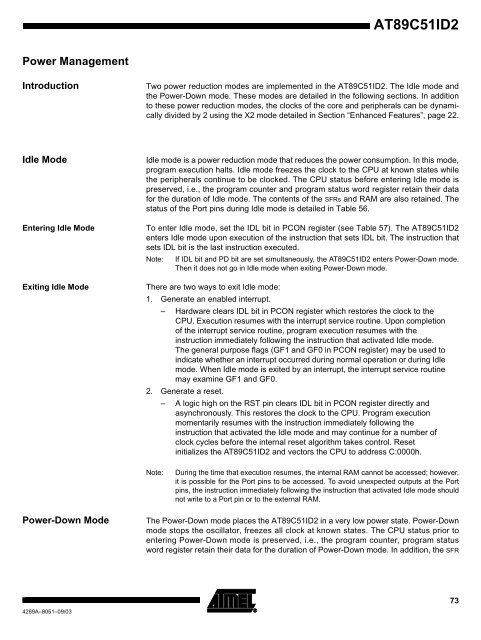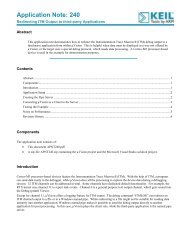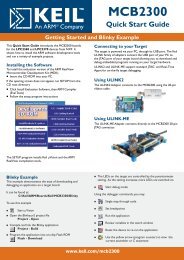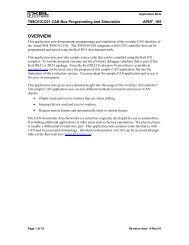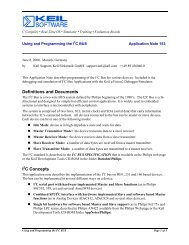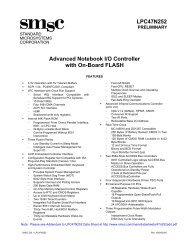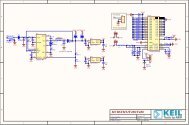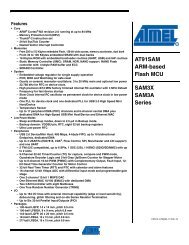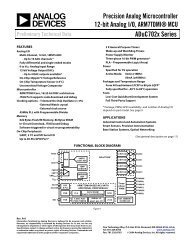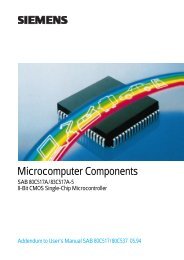You also want an ePaper? Increase the reach of your titles
YUMPU automatically turns print PDFs into web optimized ePapers that Google loves.
Power Management<br />
4289A–8051–09/03<br />
<strong>AT89C51ID2</strong><br />
Introduction Two power reduction modes are implemented in the <strong>AT89C51ID2</strong>. The Idle mode and<br />
the Power-Down mode. These modes are detailed in the following sections. In addition<br />
to these power reduction modes, the clocks of the core and peripherals can be dynamically<br />
divided by 2 using the X2 mode detailed in Section “Enhanced Features”, page 22.<br />
Idle Mode Idle mode is a power reduction mode that reduces the power consumption. In this mode,<br />
program execution halts. Idle mode freezes the clock to the CPU at known states while<br />
the peripherals continue to be clocked. The CPU status before entering Idle mode is<br />
preserved, i.e., the program counter and program status word register retain their data<br />
for the duration of Idle mode. The contents of the SFRs and RAM are also retained. The<br />
status of the Port pins during Idle mode is detailed in Table 56.<br />
Entering Idle Mode To enter Idle mode, set the IDL bit in PCON register (see Table 57). The <strong>AT89C51ID2</strong><br />
enters Idle mode upon execution of the instruction that sets IDL bit. The instruction that<br />
sets IDL bit is the last instruction executed.<br />
Note: If IDL bit and PD bit are set simultaneously, the <strong>AT89C51ID2</strong> enters Power-Down mode.<br />
Then it does not go in Idle mode when exiting Power-Down mode.<br />
Exiting Idle Mode There are two ways to exit Idle mode:<br />
1. Generate an enabled interrupt.<br />
– Hardware clears IDL bit in PCON register which restores the clock to the<br />
CPU. Execution resumes with the interrupt service routine. Upon completion<br />
of the interrupt service routine, program execution resumes with the<br />
instruction immediately following the instruction that activated Idle mode.<br />
The general purpose flags (GF1 and GF0 in PCON register) may be used to<br />
indicate whether an interrupt occurred during normal operation or during Idle<br />
mode. When Idle mode is exited by an interrupt, the interrupt service routine<br />
may examine GF1 and GF0.<br />
2. Generate a reset.<br />
– A logic high on the RST pin clears IDL bit in PCON register directly and<br />
asynchronously. This restores the clock to the CPU. Program execution<br />
momentarily resumes with the instruction immediately following the<br />
instruction that activated the Idle mode and may continue for a number of<br />
clock cycles before the internal reset algorithm takes control. Reset<br />
initializes the <strong>AT89C51ID2</strong> and vectors the CPU to address C:0000h.<br />
Note: During the time that execution resumes, the internal RAM cannot be accessed; however,<br />
it is possible for the Port pins to be accessed. To avoid unexpected outputs at the Port<br />
pins, the instruction immediately following the instruction that activated Idle mode should<br />
not write to a Port pin or to the external RAM.<br />
Power-Down Mode The Power-Down mode places the <strong>AT89C51ID2</strong> in a very low power state. Power-Down<br />
mode stops the oscillator, freezes all clock at known states. The CPU status prior to<br />
entering Power-Down mode is preserved, i.e., the program counter, program status<br />
word register retain their data for the duration of Power-Down mode. In addition, the SFR<br />
73


